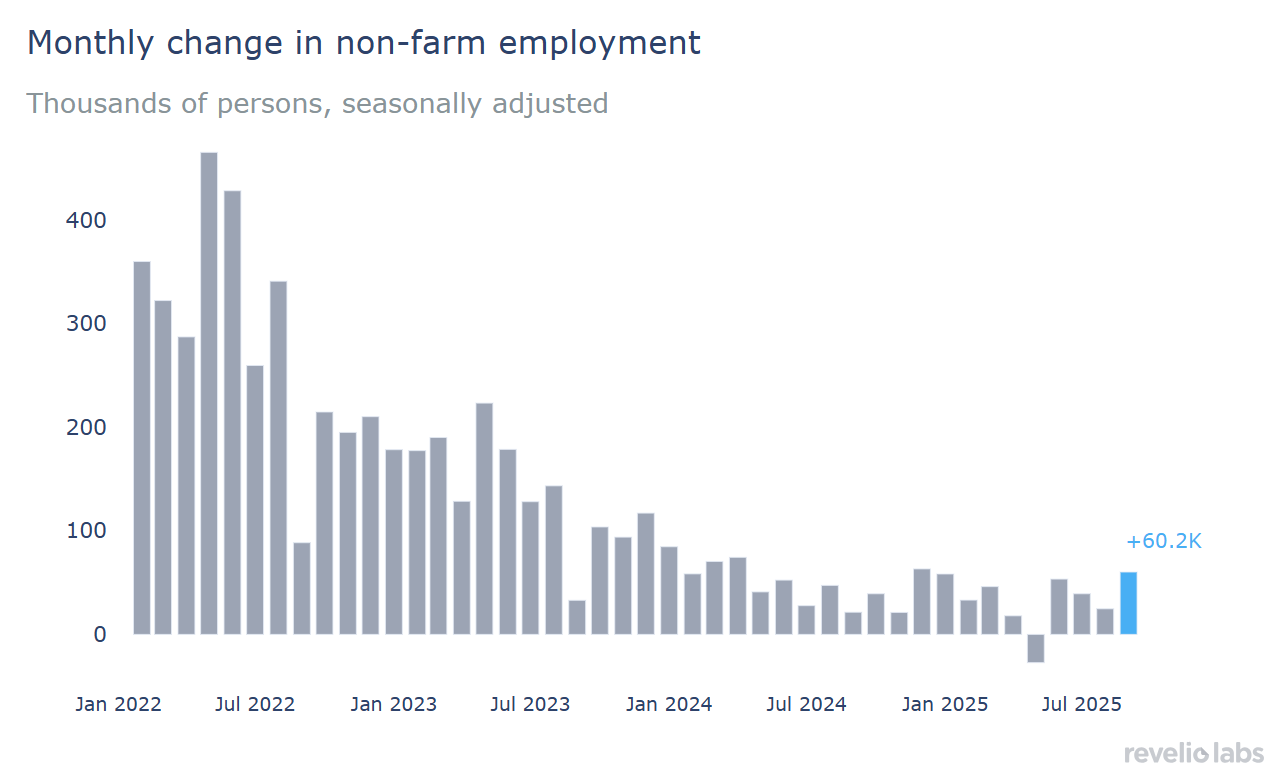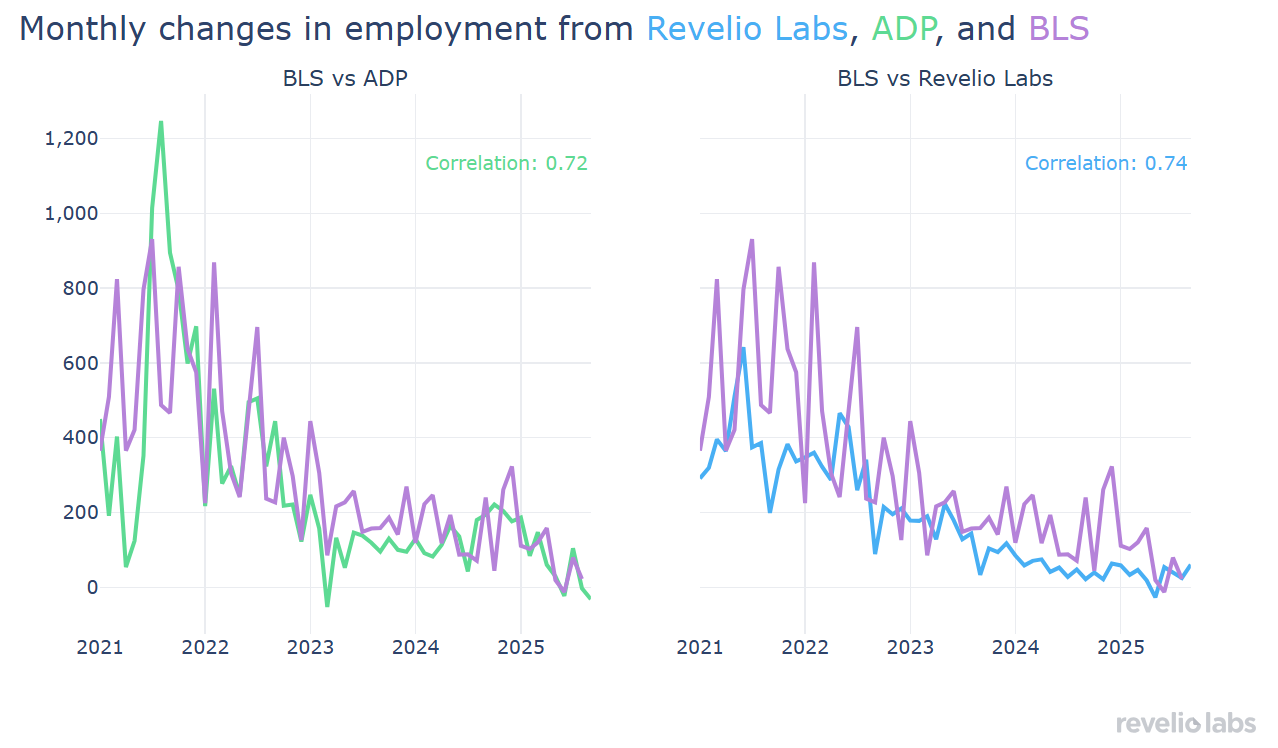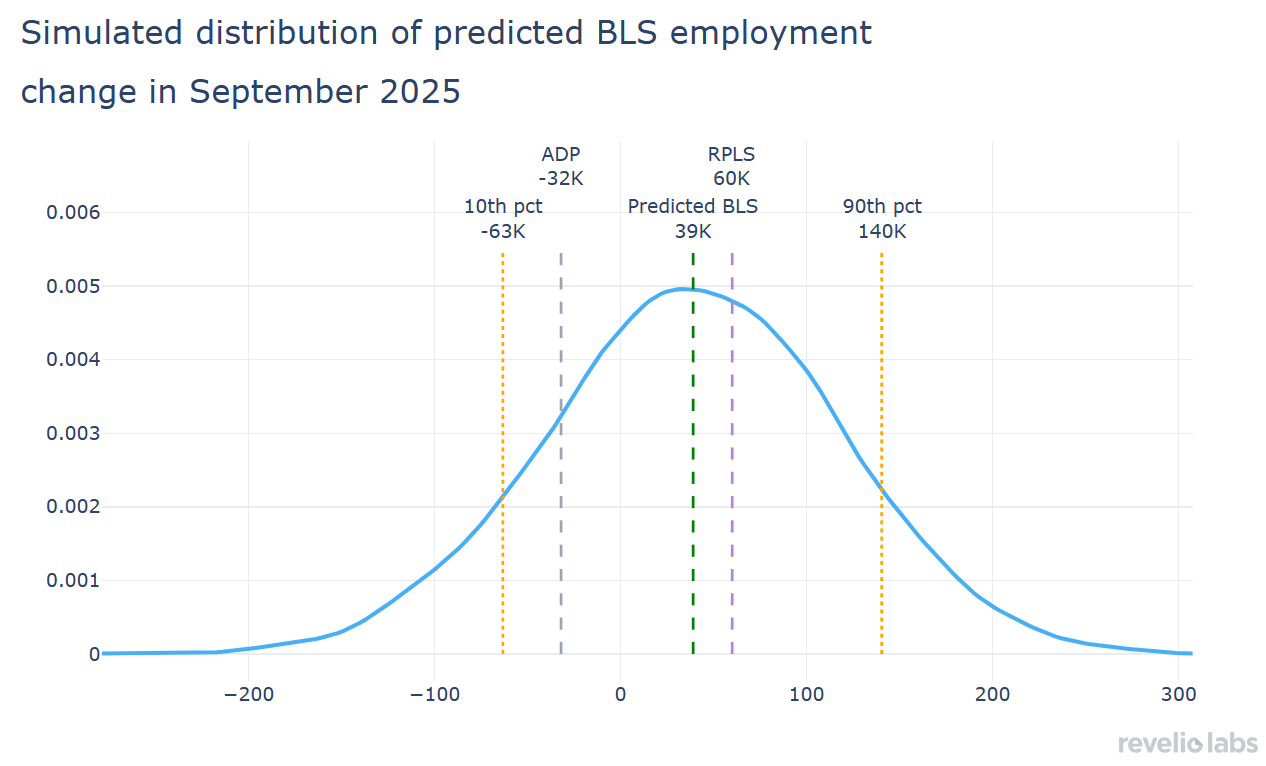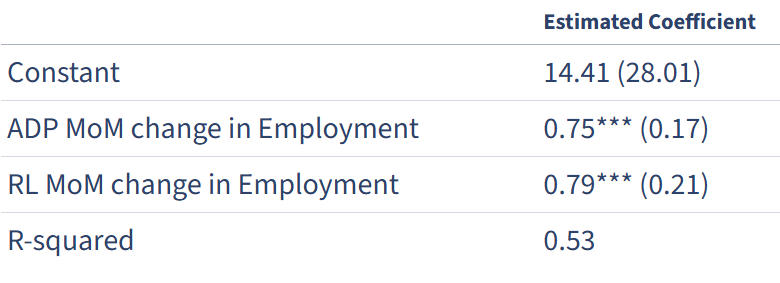RPLS Reports 60k Jobs Added in September Amid BLS Shutdown
Revelio Public Labor Statistics September release

RPLS shows the US economy added 60 thousand jobs in September, a reading that came in just above expectations, but continues to reflect the broad slowdown in the labor market.
In the absence of BLS data, RPLS can be used along with other private data from ADP to triangulate what the Employment Situation Summary for September would have been. We calculate the BLS would likely have reported approximately 38 thousand jobs gained in September.
Both job postings and salaries from new job postings decreased in September by 0.6% and 0.3%, respectively, pointing to more softening in the labor market. Additionally, as of this month RPLS also tracks aggregate mass-layoff notices from the WARN act.
The US economy added 60 thousand jobs in September according to Revelio Public Labor Statistics (RPLS). The estimated job gains come in just above consensus predictions of 52 thousand, and are significantly higher than ADP’s estimate that private employment declined by 32 thousand jobs. The Education and Health Services sector and the Retail sector contributed the most to the employment gains with 45.6 thousand and 40.1 thousand jobs, respectively. Meanwhile, the Leisure and Hospitality sector saw a decline of 34.2 thousand jobs in September. Due to the government shutdown, the BLS will not be releasing its jobs report tomorrow. As such, alternative datasets like the RPLS will play a crucial role in providing guidance on the state of the labor market.


The monthly change in employment from both RPLS and ADP is highly correlated with the BLS estimates: Revelio Labs’ correlation with the BLS’ jobs report is 0.74 and ADP’s correlation is 0.71. Meanwhile, RPLS data is only moderately correlated with the ADP data, with a 0.54 correlation, underscoring the independence of the two data series.


The highly correlated yet independent datasets can help predict the change in employment in September that would have been reported in the Employment Situation Summary. To do this, we use a straightforward time series regression model that regresses monthly changes in employment from the BLS on monthly changes in employment from both ADP and Revelio Labs. Changes in employment estimated by the BLS in 2021 and 2022 are very large and volatile. One potential reason for this is an over-capturing of true gains in employment during the post-COVID recovery in the labor market that led into the Great Resignation era. Therefore, our regression model spans the months from January 2023 to August 2025. The regression results indicate that the joint correlation between the BLS change in employment series and the change in employment estimated from RPLS and ADP is 0.71 in the period of analysis. Details on the empirical methodology are available in the technical appendix at the end of the email.
Based on the regression model, we estimate that the BLS Employment Situation Summary would have reported 38 thousand jobs added in September. Our simulation results suggest that this predicted value lies between -63 thousand and 138 thousand jobs, corresponding to the 10th and 90th percentiles of the simulated distribution of predictions and covering the central 80% of predicted outcomes.


In terms of other indicators, both job postings and salaries from new job postings decreased in September by 0.6% and 0.3%, respectively, pointing to more softening in the labor market. The hiring rate declined by 0.1p.p. in September compared to August and attrition was also down by 0.1 p.p., reflecting the ongoing decline in labor market dynamism.
Taken together, the evidence points to a labor market that is still expanding but at stall speed. RPLS indicates a gain of 60k jobs in September, while the ADP-RPLS model suggests the BLS would have reported roughly 38 thousand, with an 80% prediction range from −63 thousand to +138 thousand. Concurrent declines in job postings (−0.6%) and advertised starting pay (−0.3%) reinforce a cooling in labor demand and easing wage pressure. With the official report delayed, private indicators carry more weight; the balance of signals suggests gradual softening rather than a sharp break. Key things to watch into Q4 include the breadth of hiring across industries and advertised pay momentum—if these continue to drift lower, the slowdown is likely to broaden. For now, the labor market looks steady but fragile.
See our full release here.
We’ve designed this series to be a reliable public resource, and today’s release marks a key step forward in that mission.
Data Appendix
Using historical estimates of employment from ADP and Revelio Labs, we regress the first difference of the BLS employment series (BLS MoM employment change) on the first difference of Revelio Labs employment series (RL MoM employment change), the first difference of ADP employment series (ADP MoM employment change), and a constant term.

where t is an index for months between January 2023 and August 2025. The table below shows the estimated regression coefficients:

The coefficients on ADP monthly employment changes and Revelio Labs monthly employment changes are both statistically and economically significant, suggesting that variation in these series strongly explains variation in BLS monthly employment changes. The model’s R-squared of 0.53 corresponds to an approximate correlation of 0.73 between the BLS series and the combined ADP and RL series.
These estimated regression coefficients are then used to nowcast the BLS month-over-month change in employment based on the observed values of ADP and RL monthly employment changes. To quantify uncertainty around these predictions, we run simulations using the regression results, generating a distribution of estimated BLS MoM changes in employment. This distribution allows us to assess likely ranges and percentiles for the predicted employment change.

